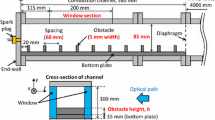Abstract
Experiments are carried out to investigate the mechanism of the deflagration-to-detonation transition (DDT). Because, this mechanism has relevance to safety issues in industries, where combustible premixed gases are in general use. A stoichiometric gas of oxygen and hydrogen (oxy-hydrogen) is ignited in a tube, repeated obstacles are installed, and the DDT behaviours are visualized using a high-speed video camera. The pitch and height of the repeated obstacles and the initial pressure of the oxy-hydrogen premixed gas are varied in an attempt to obtain the optimum conditions that cause DDT a short distance from the ignition source. The experiments identified DDT as being essentially caused by one of the following mechanisms: (1) A deflagration wave is accelerated in terms of a vortex, which is generated behind the obstacle, and the flame acceleration induces a secondary shock wave. Eventually, the shock–flame interaction ahead of the obstacle causes DDT via a very strong local explosion. (2) Each shock wave generated by relatively weak local explosions between the obstacles is not sufficient to cause DDT directly, but DDT results from an accumulation of shock waves. The detonation induction distance is also examined, taking into account the physical and chemical parameters of the obstacles and the oxy-hydrogen premixed gas.














Similar content being viewed by others
References
Urtiew, P.A., Oppenheim, A.K.: Experimental observation of the transition to detonation in an explosive gas. Proc. Roy. Soc. Lond. A 295, 13–28 (1966)
Moen, I.O., Donato, M., Knystautas, R., Lee, J.H.: Flame acceleration due to turbulence produced by obstacles. Combust. Flame 39, 21–32 (1980)
Lee, J.H.S.: The Detonation Phenomenon. Campridge University Press, Cambridge (2008)
Kuznetsov, M., Alekseev, V., Matsukov, I., Dorofeev, S.: DDT in a smooth tube filled with a hydrogen–oxygen mixture. Shock Waves 14, 205–215 (2005)
Zhu, Y.J., Chao, J., Lee, J.H.S.: An experimental investigation of the propagation mechanism of critical deflagration waves that lead to the onset of detonation. Proc. Combust. Inst. 31, 2455–2462 (2007)
Teodorczyk, A., Lee, J.H.S., Knystautas, R.: Propagation mechanism of quasi-detonations. In: Proceedings of the Symposium (International) on Combustion, vol. 22, pp. 1723–1731, (1989)
Teodorczyk, A., Drobniak, P., Dobkowski, A.: Fast turbulent deflagration and DDT of hydrogen-air mixtures in small obstructed channel. Int. J. Hydrogen Energy 34, 5887–5893 (2009)
Ciccarelli, G., Boccio, J.L.: Detonation wave propagation through a single orifice plate in a circular tube. In: Proceedings of the 27th Symposium (International) on Combustion, Combustion Institute, pp. 2233–2239 (1998)
Ciccarelli, G., Flowler, C.J., Bardon, M.: Effect of obstacle size and spacing on the initial stage of flame acceleration in a rough tube. Shock Waves 14, 161–166 (2005)
Johansen, C.T., Ciccarelli, G.: Visualization of the unburned gas flow field ahead of an accelerating flame in an obstructed square channel. Combust. Flame 156, 405–416 (2009)
Ciccarelli, G., Johansen, C.T., Parravani, M.: The role of shock–flame interactions on flame accerelation in an obstacle laden channel. Combust. Flame 157, 2125–2136 (2010)
Card, J., Rival, D., Ciccarelli, G.: DDT in fuel–air mixtures at elevated temperatures and pressures. Shock Waves 14, 167–173 (2005)
Gamezo, V.N., Ogawa, T., Oran, E.S.: Flame acceleration and DDT in channels with obstacles: effect of obstacle spacing. Combust. Flame 155, 302–315 (2008)
Gamezo, V.N., Ogawa, T., Oran, E.S.: Numerical simulations of flame propagation and DDT in obstructed channels filled with hydrogen–air mixture. Proc. Combust. Inst. 31, 2463–2471 (2007)
Dorofeev, S.B., Sidorov, V.P., Kuznetsov, M.S., Matsukov, I.D., Alekseev, V.I.: Effect of scale on the onset of detonations. Shock Waves 10, 137–149 (2000)
Liu, Y.K., Lee, J.H.S., Knystautas, R.: Effect of geometry on the transition of detonation through an orifice. Combust. Flame 56, 215–225 (1984)
Obara, T., Yajima, S., Yoshihashi, T., Ohyagi, S.: A high-speed photographic study of the transition from deflagration to detonation wave. Shock Waves 6, 205–210 (1996)
Grondin, J.S., Lee, J.H.S.: Experimental observation of the onset of deonation downstream of a perforated plate. Shock Waves 20, 381–386 (2010)
Kuznetsov, M.S., Alekseev, V.I., Dorofeev, S.B.: Comparison of critical conditions for DDT in regular and irregular cellular detonation system. Shock Waves 10, 217–223 (2000)
Sorin, R., Zitoun, R., Desbordes, D.: Optimization of the deflagration to detonation transition: reduction of length and time of transition. Shock Waves 15, 137–145 (2006)
Nagai, K., Okabe, T., Kim, K., Yoshihashi, T., Obara, T., Ohyagi, S.: A study on DDT processes in a narrow channel. In: Proceedings of the 26th International Symposium on Shock Waves, CD-ROM (2007)
Peraldi, O., Knystautas, R., Lee, J.H.: Criteria for transition to detonation in tubes. In: Proceedings of the 21st Symposium (International) on Combustion, Combustion Institute, pp. 1629–1637 (1986)
Gamezo, V.N., Khokhlov, A.M., Oran, E.S.: The influence of shock bifurcations on shock-flame interactions and DDT. Combust. Flame 126, 1810–1826 (2001)
Ohyagi, S., Obara, T., Hoshi, S., Cai, P., Yoshihashi, T.: Diffraction and re-initiation of detonations behind a backward-facing step. Shock Waves 12, 221–226 (2002)
Sentanuhady, J., Tsukada, Y., Yoshihashi, T., Obara, T., Ohyagi, S.: Re-initiation of detonation waves behind a perforated plate. In: Proceedings of the 20th International Colloquium on the Dynamics of Explosions and Reactive Systems, CD-ROM (2005)
Obara, T., Sentanuhady, J., Tsukada, Y., Ohyagi, S.: Re-initiation process of detonation wave behind slit-plate. Shock Waves 18, 117–127 (2008)
Acknowledgments
The authors would like to thank Messrs T. Yoshihashi, Y. Okada, and S. Iwata of Saitama University for their technical assistance in acquiring the experimental data, and Messrs K. Yanagisawa and S. Matsumura of nac Image Technology, Inc. for their technical support in visualizing the DDT processes using a high-speed video camera.
Author information
Authors and Affiliations
Corresponding author
Additional information
Communicated by L. Bauwens.
Rights and permissions
About this article
Cite this article
Obara, T., Kobayashi, T. & Ohyagi, S. Mechanism of deflagration-to-detonation transitions above repeated obstacles. Shock Waves 22, 627–639 (2012). https://doi.org/10.1007/s00193-012-0408-5
Received:
Revised:
Accepted:
Published:
Issue Date:
DOI: https://doi.org/10.1007/s00193-012-0408-5




